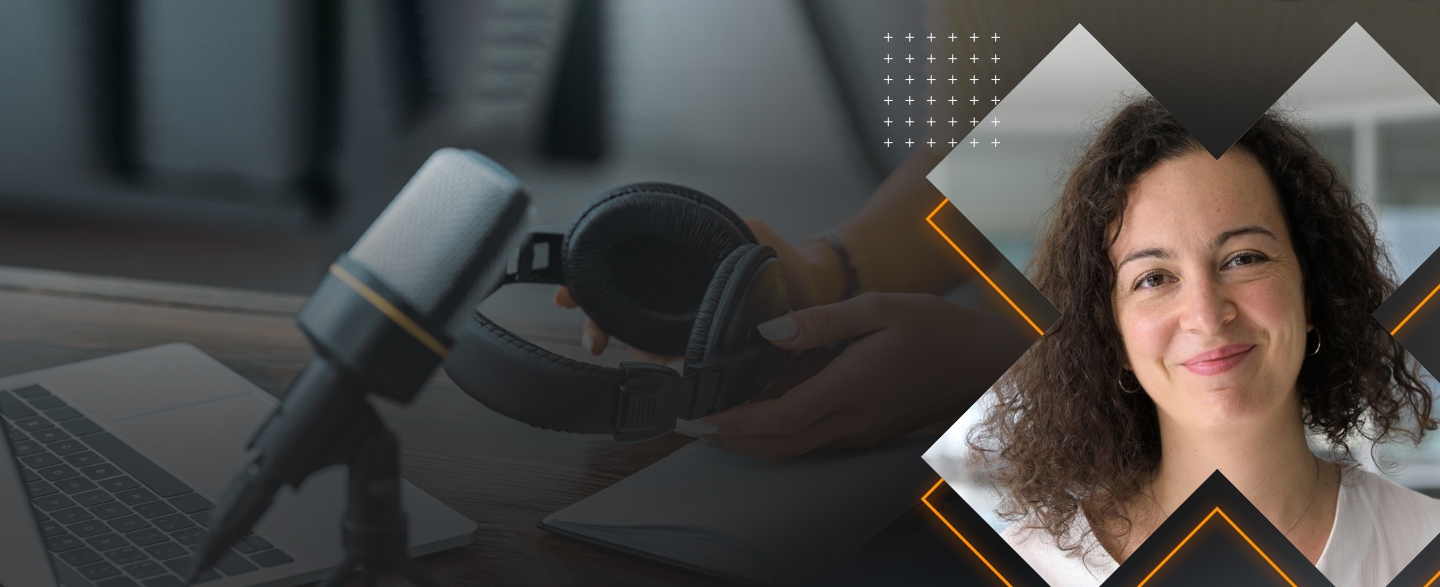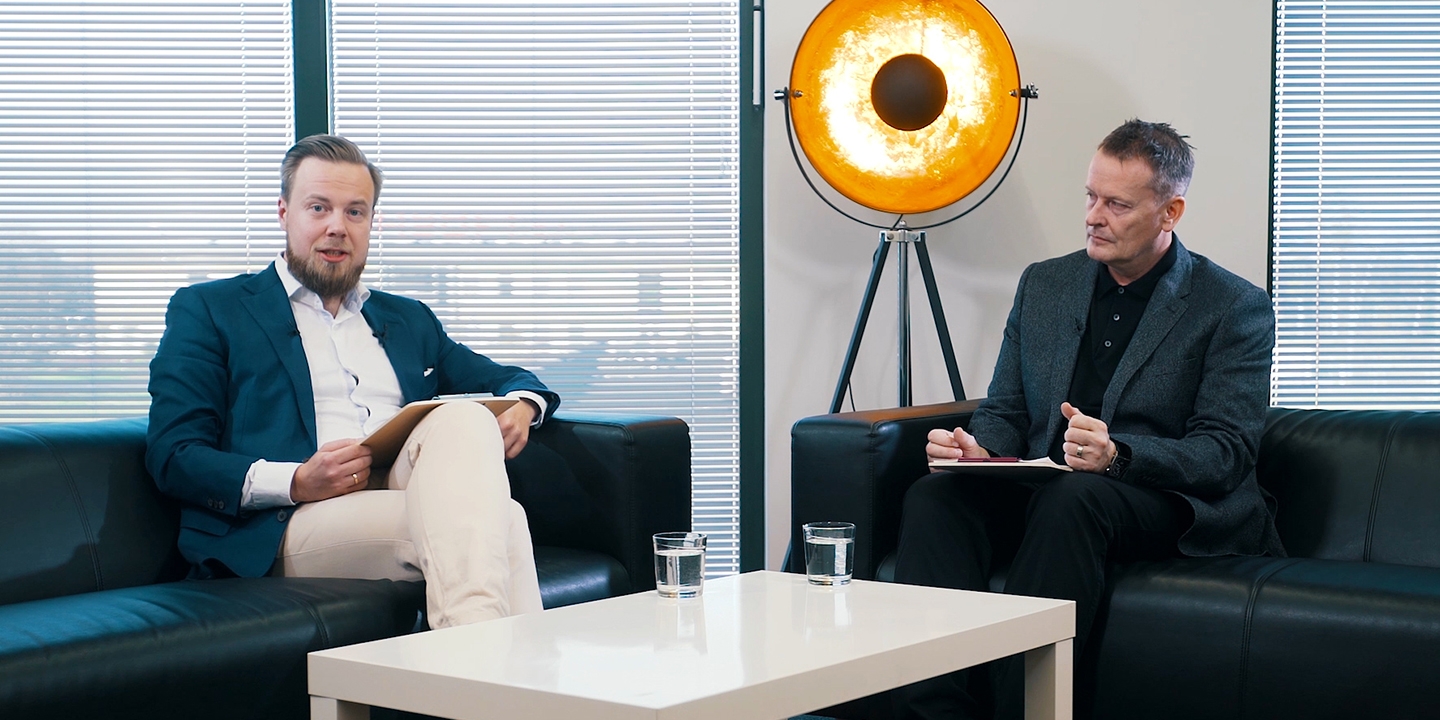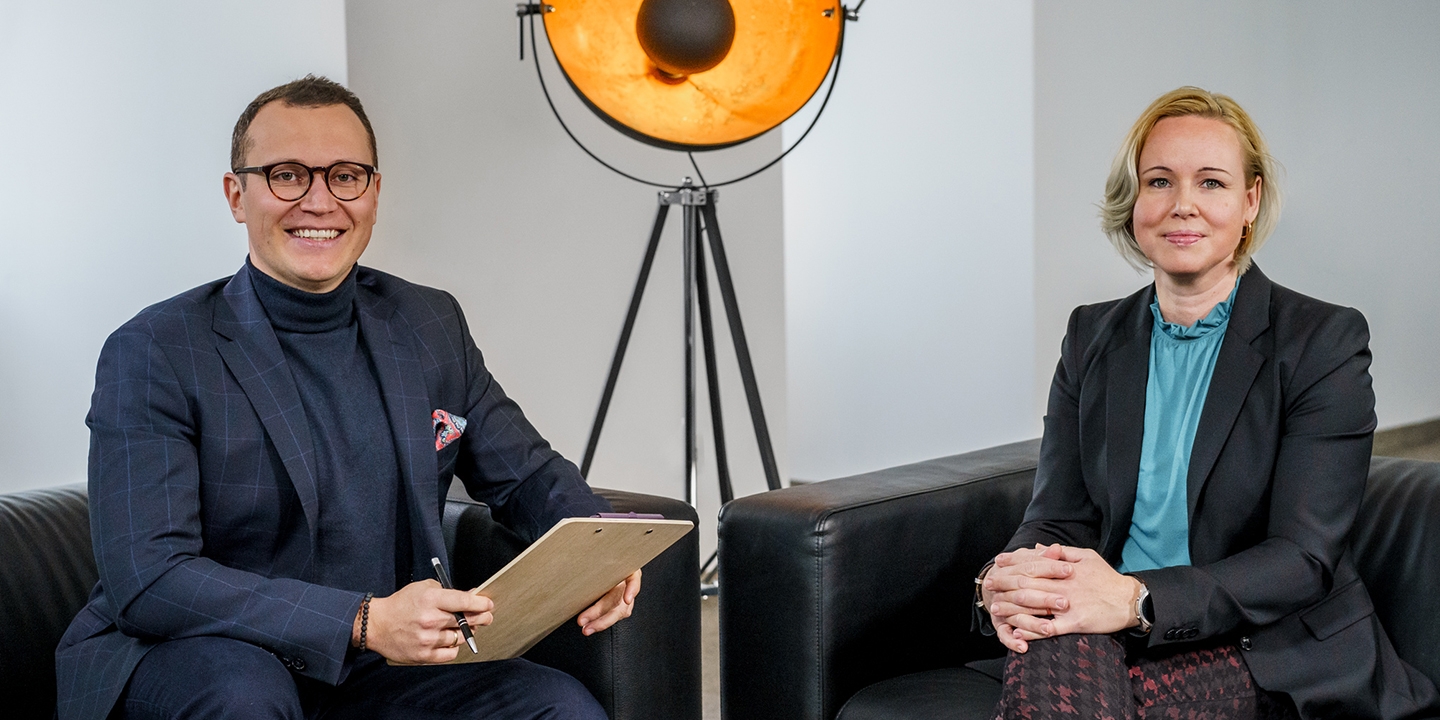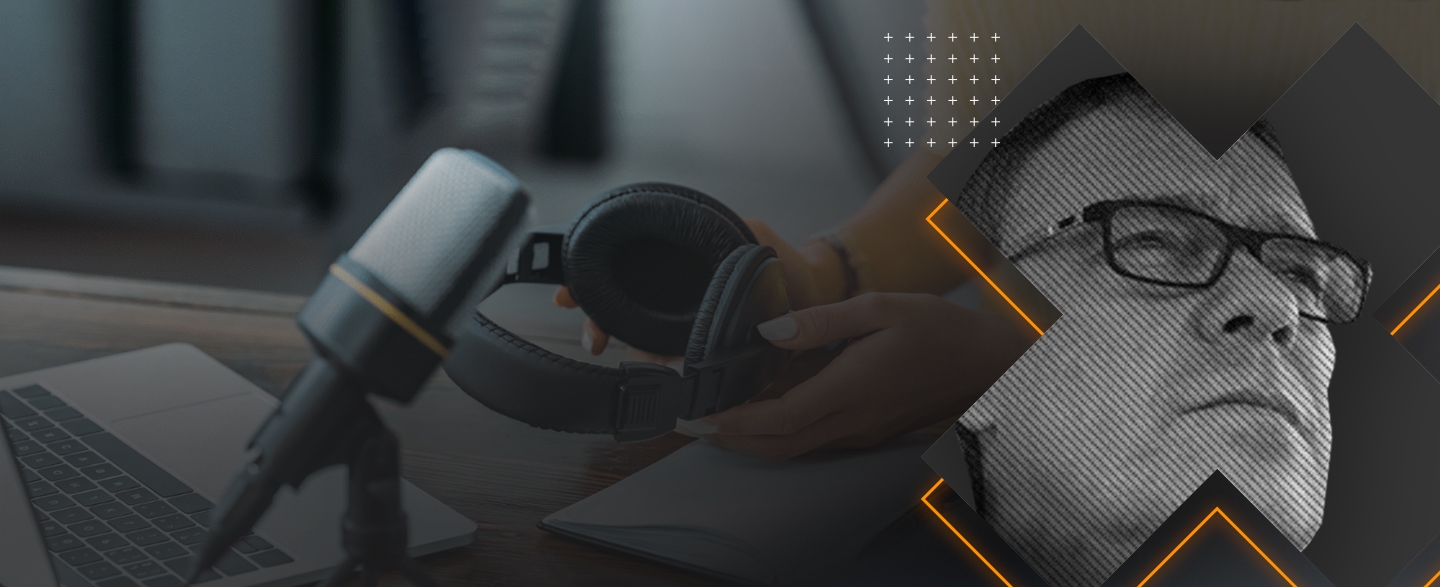- Insights hub
- /
- Digitalisation at scale –...

Digitalisation at scale – how large enterprises tackle change, transformation and innovation with Noémie Ellezam
- DetailsAbout the talks
- TranscriptTranscript
Digitalisation at scale – how large enterprises tackle change, transformation and innovation with Noémie Ellezam
Michał Grela
Relationship Manager at Future Processing
We often believe that larger organisations are not that agile and rather resemble a tanker when it comes to introducing innovations and responding to change. Is it a fact, or a myth? Let’s find out!
In this talk with Noémie Ellezam, Chief Digital Strategy Officer at Société Générale, we discussed her experience in approaching agility and complex strategies in big organisations as well as the role of data in such endeavours. We also touched upon implementing digital transformation in a decentralised model, monitoring the progress and results of the digital transformation as well as how to stay customer focused and make technology efficient at the same time. Noemie also shared her tips and lessons learnt based on her experience.
Michał Grela (MG): Hello, and welcome to another episode of our IT Insights talks on business and technology. Today, my guest is Noémie Ellezam of Societe General. And we’re going to discuss agility at scale and how large enterprises tackle change, transformation and innovation.
And a small forward. Often, we believe that larger organizations are maybe perhaps not that agile and rather resemble a tanker when it comes to introducing innovations and responding to change. But is it a fact or is it rather a myth? Let’s find out. Hi, Noémie. It’s super good to have you. Thank you for finding the time for this recording.
Noémie Ellezam (NE): Hello, Michał. I’m very happy to be with you today. Thank you for inviting me.
MG: Brilliant. Can you introduce yourself to our guests, please? Say a few words about your role and the organization.
NE: Yes, of course. I am Noémie Ellezam. I am the Chief Digital Strategy Officer for the group Societe General. Societe General is a major financial service European group. We operate in 61 countries, and we are a company of 130,000 staff, operating in very diverse businesses. We are let’s say on three main strategic pillars, which are retail banking, wholesale banking, and also mobility because we have a very big activity with ALD on mobility. And some news recently in the press with the acquisition of list planner, which is enforcing this part of our activity.
As a Chief Digital Strategy Officer for the group Societe General, my job is to be in charge of designing with our business units and delivering at the group level or digital transformation for our customers and our three pillars and our 61 geographies.
MG: Sounds really challenging and sounds like definitely, Societe General is a huge organization. How do you even manage or how do you even approach such a complex strategy in such a big organization? How do you eat this elephant? Just maybe few words of a context before we dig into the questions. How do you even do it?
NE: Yeah. I think that the question of agility in big corporates, behind this question, there is always the question of centralization or decentralization. There are two main ways to appear transformation in very big groups. There are groups, I think about maybe American players, which are very centralized because of their market, which is huge in itself with a common regulation and common customer usage, and so on. In Europe, there is much more models which are much more decentralized and Societe General is really part of it. And I think it’s really a good thing because, on European markets in particular, it allows us to have a digital strategy and a transformation strategy, which is really sticking to our customer expectations. And also, to the local regulations, which are very different depending on the countries where we are.
In this context, we decided in Societe General to operate the digital transformation in a very distributed way. Which means that we have a division centrally, which is coordinating, supporting, and empowering the teams within the business unit to have a group strategy of transformation and digital transformation.
But to operate and deliver this strategy, we rely on a network of 60 very senior digital leaders across all our business units and geographies. When I say digital leaders, these people, they are part of the business unit Exco. They are very senior managers. And they are the people really in charge to deliver the transformation strategy, but they also operate as a community, as a collective. And they share common governance, common steering. And we can dig into how we operate this governance later, but this really is a distributed way of carrying on the digital transformation Societe General.
MG: Thank you for that explanation. That really does sound like a sound approach. You already managed to answer two of my first questions. How can you actually distribute or do you distribute approach to change, transformation and digitalization? And as you explained, you are doing it per geographies or let’s say different context.
And my second question that you already answered was how do you introduce any sort of organizational structure to maintain efficiency? How is it so far playing out for you? Because distributing something in 60 parts sounds like it is a very big distribution? Is it manageable? Is it effective? Or how do you introduce, maybe you can tell us something more about this governance structure that I guess makes sure that, or is there introduced in place to make sure that the effectiveness is relevant?
NE: Yes. Absolutely, you are right. This was one of our challenges when we started our journey at the group innovation division, because I’m part of a group innovation division which is attached directly to the general management. We had this challenge to say, what is the right let’s say unity to put the distribution in motion?
We started by identifying these 60 digital leaders in the businesses. I insist on this because they are not on the IT part. They are definitely on the business part. And then, to build up governance and let’s say, a sound steering also on the strategies, what we’ve done is that we’ve sub-divided, let’s say the digital leaders around our main customer basis. We have one part which is around individual customers. Many of our businesses serve individual customers, being mass-market or being affluent customers or being private customers.
We have another one which is enterprise customer, where we put small caps, large corporates, and also financial institution. Because again, there is the same problematic to serve digitally those customers. And then we have another pillar, which is our support function, who also need to go through a very big digital transformation and they have the same problematics in the end. Should you work in a risk division, or in a compliance division, or in the finance division of a very big corporates in the end, your problematics in term of digitization are pretty much the same.
The way we are making work, this governance that we have three digital SteerCos, what we’d call digital SteerCo, where we gather every six weeks, the digital leaders of the business unit committed for our customers, individual enterprise or support function. And in this committee, they share four things. That are data-driven, market assessment. That means that we perform together and they perform together benchmarks. But with the same structure and framework. External and competitive benchmarks. They perform the voice of the customer analysis. Again, sharing the methods, sharing the results and sharing their earnings. This is the first thing they share.
The second thing they share is a level of ambition and an outcome based tiering of the digital investments. They share a common methodology to say, “Okay. Here is where we are now in comparison to our competitor. Here is where we want to land in one year, two years, five years. And here is the amount of investment we put into and we follow together. Are we going at the right reason to reach our ambition?”
And this was built also in the time we started by assessment. Then we went on with the steering and now we are at the level where they start sharing some bricks of the operating model, being choice of organizations or upskilling strategies, or even selected capabilities about marketing stack, for example. Where they know they have to build it in the different entities where they are operating.
They know that it will be a very big investment and they know it worth it to work it collectively on this problematic. This is the way we make it work let’s say, even in a very big corporate and with a great diversity of activity and of geographies.
MG: Wow. That’s amazing. How this is if are the 60 leaders? I mean, how autonomous are they? What’s within their power of authority, because what I mean by this question is that I assume that the goal of the organization is to let’s say, ensure a similar level of quality of services in the 60 branches. But in order to, of course, from the one hand they all have to be equal in outcomes. On the other hand, as you said, the diversity is great. And I guess that requires some sort of flexibility and individual approach in every one of the situations. How do you balance that?
NE: I will take the example of retail banking because it’s easier maybe on this example. What we’ve done is basically, we have the same nature of metrics and targets. We follow two main metrics which are digital sales and digital new customer acquisition. Because we think it’s really important to follow those two metrics, for example, to really let’s say, assess our speed of transformation.
We follow the same metrics in all our entities in Europe. But of course, the target we put for each entity is different because the reason of change in customer expectation is not the same. And also, the strategic and the competitive position of each of our entity on its own market is not the same. This, we discuss it with the digital leader. To answer your question, they are absolutely decisive within their B1, because they are part of the Exco. The target is agreed with the digital leader and with the head of business unit.
The global target at the group level makes part of the objective of the Exco of the group, so at highest level. And we report on our achievements annually to our board of administrators. The governance is very robust and very solid. All this process is also embedded in our financial governance. That mean that there is let’s say a focus every quarter. When we look after our financial results, we also look on this specific part, which is digital investment and outcome coming from this digital investment. And where we are compared to our targets. Do we have to accelerate, or are we on track?
This is the way it works. And there is, let’s say this target, they allow to have a very great alignment on the target and on the North Star. But it also allow and it’s absolutely essential to have a effectiveness in the execution. It takes into account the local specificities. And also, the other strategic project, the business unit have to deliver at the same time of the digital transformation. Because what is very complicated nowadays, that there are huge transformation at scale, besides digital transformation.
It’s sustainability transformation is also a huge topic. When you are a head of a business unit, there are many priorities. The idea is really to work in good intelligence with them to be able to put the right target, to stay a leader, because we want to be a digital leader. And we are a digital leader in many of our markets.
But at the same time you have also to deliver the other strategic projects. For example, in France, we are merging our two main networks. This is a very big strategic project, which has of course, a digital dimension. But not only it’s much more like that. It’s a very new bank that we are building.
We have to manage this different level of priority. And for this, we need to have a very good level of dialogue and of strategic understanding also of the sum of constraints, our head of business unit and digital leader operating too. And I see, this is the key for successfully execution to be able to coordinate.
MG: How do you monitor the progress and results? What tools do you have in place?
NE: There are different level of tools. There are very operational tools, which are used by the digital teams, which are the tool that different type of analytics and so, a very operational tool. And then, they are also, of course, we use our customer data and all the data we produce on the journeys of the customer. Being digital journeys, but not only I talk also about internal journeys.
Each entity, sometimes they have the same tools, sometimes they don’t. They produce their metrics. And then, we use, let’s say the fact that as I was saying, the process is embedded within the financial process also. To be able to ensure, let’s say the same definition and the same way of gathering the information to have consistent metrics, to report both internally for our general management, but also to our board. And also, to the external partners, our stakeholder that we have.
This is the way we are working. And also, I was talking at the beginning, maybe it’s interesting because one of the first things we have done to be able to put this consistency in place was external benchmarks, because we needed to know how we were positioning. And here we are working with a partner, which is also a good help for us to align on methodology, to be able to calculate just the same indicators everywhere, because when you have worked a bit in retail banking, you know that a customer is not always a customer.
It’s very helpful to be able to align on definitions and be able, whatever is the strategies and whatever is the systems, to have comparable figures. And to talk about the same thing and to talk, let’s say about the real topics. Which is which journey do you want to follow and which speed you want to get to achieve, to transform the model?
MG: Amazing. Yeah, definitely. It sounds like there was a lot of just ground level work, homework to do first to make sure that you are all on the same page. What I also wanted to touch base on was this, let’s say there’s always this tension between client orientation and how to be customer oriented in all of these different changing contexts. And on the other hand, this let’s say technical efficiency and what is the technology allowing us on doing. How do you stay on top of that risk?
NE: Of course, it’s always the same challenge. And we try to really, we are driven by customer excellence in all this digital strategy. We really are looking every day, every time on the market, on the voice of customer on one side, but also on all the new propositions of value, which are coming on the market and they are really dynamic as you know. And I’m not of course, talking on nearby banks, but coming from fintechs and also big tech or big players, which are very advanced.
I think one thing which is very important, because of course, this is the customer part. And then on the technology part, of course there is a legacy. Of course, it’s a big company with also a very big, let’s say requirement in term of quality. Because the trust of our customer is really our treasury.
MG: Of course.
NE: We have to take care of these goals, let’s say. Of course, we have processes, we have security processes, we are compliant with. And this is good for our customers, so we have to be conscious of this. I think let’s say one way to answer your question is to talk about maybe openness. We definitely have to be open to our ecosystem. We have to work with partners as much as we can.
They are asking that we really want to keep doing ourselves because it’s our core value added, or because it’s so important that we really need to have it inside the bank. But there many things that we can do with partners and that we are doing with partner. I will take one example, for example. I talk about individual customer, but if we talk a bit about enterprise customer, there is a very big transformation on SME banking at the time being, which is not a very easy topic.
And because again, the local markets in Europe are very different and so on. It’s not always easy to invest everywhere on everything. And for this, for example, we have recently signed a partnership with a fintech, which is called Kyriba, which are for the treasury management system, very embedded with different financial services for SMEs. And this is an example of the fact that we know that at the time being, there is a great proposal on the market for our customer. We want to make our customer benefit from this proposition, which is also a way to offer in the smoothest way, our own services in terms of transaction banking, for example. We do not hesitate to put these partnerships in place. And I think this will be accelerating in the coming years. And the second maybe way to materialize this openness is also to make some acquisitions. Sometimes we have to know how to buy something in that a way there is a build, you know the partner and the buy. The buy is also a very good way to be able to answer to some customer expectation. We were not able to answer in the right, let’s say pace. And here, the challenge becomes integration. It’s always the same question. How do you iterate and let’s say scale up or help the fintech you’ve bought in its development without killing it? And here, I think we have very, very good experience. And we started our first acquisition in Societe General in 2015 with a society which is called Fiducéo, which was an aggregator. We have now quite a lot of years of experience about it. And we know now how to succeed in integration and how to put some people from the bank within the startup, how also to take benefit of the practices of the startup to also make our own culture progress in term of agility and velocity. I think this is also a very big let’s say, answer to your question to say customer expectation are changing very fast. IT is changing also very fast, but it’s not always possible to match on all customer expectation.
MG: Yeah, keep up. No, you have to juggle, definitely. I really liked a bit about partnerships and acquisitions of course. But partnerships first. And it’s definitely a trend in the let’s say financial industry that big organizations are partnering. Or let’s say incumbent organizations are partnering with more nimble and agile fintechs in order to supplement their let’s say, service offering. That’s a confirmation of that trend, definitely. And what’s the role of data in all of these initiatives? I mean, how heavily are you relying on data? Is it rather helpful or maybe more challenging to be data driven?
NE: It’s absolutely key and core and it’s challenging. Because of course, we have many, many data. Banking is a data business since ages. The topic now is to say, “Okay, there is a technology affair and this, that mean that we need to build the infrastructure to be able to use at scale or the data that we have in the respect, of course, of the regulation and the customer privacy.”
And so, there is all this part which is really challenging because we are also in a context where regulation is becoming very strict on data usage and so on. This is the challenging part, of course, but if you look at it from a business point of view and for let’s say a use cases point of view, of course, data is a huge enabler to be able to have seamless experiences for our customer.
We are now able to fill automatically all the subscription forums and so on, which is a huge gain in term of customer experience, for example. It’s a very powerful level in term of personalization, of course. The customer are waiting now from their bank a very high level of knowledge. Not only human knowledge, which was already one of power value added, but also now, an instant and very deep and very even predictive knowledge.
Here, of course, by personalization, data is absolutely key to make the difference. But it’s also very useful to be able to win in terms of efficiency, internal efficiency. Which also for the customer means to be more competitive in term of pricing, which is very important. I will take the example, for example. We have a full online bank in France, which is a called Boursorama, which is a huge full online bank and a very unique player in the French market.
And to serve 4 million clients, we only need 800 staff. Which means that this bank is recognized by the customer with the highest levels of that situation and the cheapest bank in France since years. This also show that in a digital model, when you are able to use the data correctly, you can earn efficiency. And you can give it back to our customer in term of satisfaction and in term of pricing.
And maybe the last domain, when we can use data and really value from data, is to be able to manage risk with more accuracy and more efficiency. And for example, we now have several data and AI products, which allow us to detect, for example, an operation that fraud at the moment of the payment and push an alert to the customer for him to confirm in real time that the payment is really originated by him. And that this is not a fraud.
Yeah, on this four area, data and above all, AI, will definitely be a game changer. But put it in place at scale, of course, it’s a challenge. And as digital, it also requires a very deep change in term of mindset of culture. And this is all the story of digital transformation. It’s not a technology. It’s a technology shift, but it’s also a very big culture and mindset shift. Yes, of course it’s a challenge.
MG: Glad that it at least is proven to bring results, even though it’s challenging. This is last final question before we finish. Can you share any mistakes made along the way? Because where you are now is definitely, let’s say an effect of years of testing and experimenting with all the infrastructure, with all the governance, with all the tools and distribution. And it’s an effect of yearlong adventure and journey. Perhaps any lessons learned, or any avenues that you explored that you are not exploring anymore. Any mistakes that you’d like to share as a know-how piece of your organization towards our listeners.
NE: Yes. I think the difficulty with the transformation journey we are talking about is that it’s a long journey. You have, let’s say, to maintain the focus years after years. And again, with many other things that are happening while you are transforming your organization. There is really a need of consistency.
And at the same time, there is a need also, let’s say, to balance always between big alignment focus, and on the other part, creativity and empowerment of people and so on. I think, what is not easy is to say, when is it the right time let’s say to share a North Star and let people experiment and do some perks and experiment? And also, upskill themself by doing because I think this is very important in the journey of awareness and senior and mid-management, let’s say upskilling it to have these periods where we accept that, “Okay, we are testing.”
And to know when it’s time to say, “Okay, now we need a structure and we need priority. And we cannot try to do too many things in the same time. Because digital is a scale business and at some point we need to scale.” And I think one example for us, was what we’ve done with the new business part, because I have talked quite a lot about the transformation of the core, which is one part of our activity. But we also work of course, on new business to be able to build up the business of the future, which will be maybe our core business in 10 to 15 years, but we have to work on it now.
And here, there was a time where we were really experimenting in many directions. And there was a time when we need to say, “Okay, we have now five priorities. These are our priorities. Maybe there are promising markets we are not working on, but let’s strike on the four, five direction where we really think that we have a right to win. And we have really, the potential to make the difference.”
Yeah, that would be my answer. Which is, I think what is key is to always be in the mindset of reset, to say, “Okay, this year, what we wanted to do, what we’ve achieved. And now, do we have to change, even if the recipe was working until now? Is it still the right recipe for the coming year? Or do we have to change the recipe? Because that the recipe has done the right cake, but now this is another cake that we want to build, so we have to do things differently.”
And when you operate centrally with a very small team, which is our case. We have a very small team centrally because we want to keep execution close to the customers and locally. We always have to ask ourselves this question, because we have limited means.
MG: Everything that you just explained, sounds like it is very complex and takes time, but I guess that judge them by results. Can you share some results? Is it a robust process? Is it taking that long time, or maybe it’s faster than one can expect. What are the results?
NE: Yeah, of course. It takes time. It is complex, but it works. I mean, and it’s not so slow because I will take only one example. I was still telling you that in retail banking, we are offering two main indicators, which are digital sales, full digital sales and full digital new customer acquisition.
When we started this acceleration in 2019, basically, when we’ve done our first benchmark, we were between zero and 5% on each of this indicator, depending on the geographies. And it was very, very boosted by very advanced markets. Now, after three years we’ve disclosed our 2021 results yesterday. And you can see that we acquire 40% of our new customer, individual customers fully digitally. And we also sell 28% of our core product to individual customer fully digitally.
It’s a huge transformation of the model, which has followed the reason of the transformation of the customer expectations, of course, accelerated by the COVID crisis. But we showed that we had the ability to be there when the customer were ready to consume more digitally their financial services. I think this is a very good example.
Another good result that I can share with you is that our full digital bank, for example, in France, which is called Boursorama, is in a huge dynamic of customer acquisition. To give you only one figures, they acquire 100,000 customer only in December 2021. It’s a huge acquisition dynamic.
And it shows that the model we have put in place with some full digital engines, building internally or about. We also have a bank for a professional, for example, which is fully digital. They follow a very rapid growth dynamic. And our more traditional entities, they also manage to disrupt and to make their business model evolve according to the customer expectation at a very rapid pace in the end compared to their importance.
MG: Sounds like a definitely good lesson learned to share. Thank you for that. And thank you for taking part in the podcast. It was a very interesting conversation about how large organizations, such as Societe General, tackles digitalization at scale with the governance structure in place, what’s the infrastructure, what’s the division, what’s the role of data. How do you stay customer focused and make the technology efficient? What was the role in partnerships? We covered all that. Thank you. Thank you, Noémie. It was great pleasure.
NE: Thank you very much. And it was a great pleasure to talk to you too. Thank you again, Michał.
MG: Thank you. Take care. Thank you for listening to our podcast, dear guests. And if you found it useful, please don’t hesitate to like it and share it on social media. And do drop us a line if you would like to have another topic covered in one of the future episodes. That was IT Insights with Noémie Ellezam. Thank you.
INSIGHTS
Check similar insights
Contact
Get in touch
Have any question about specific material?
Let us know!







